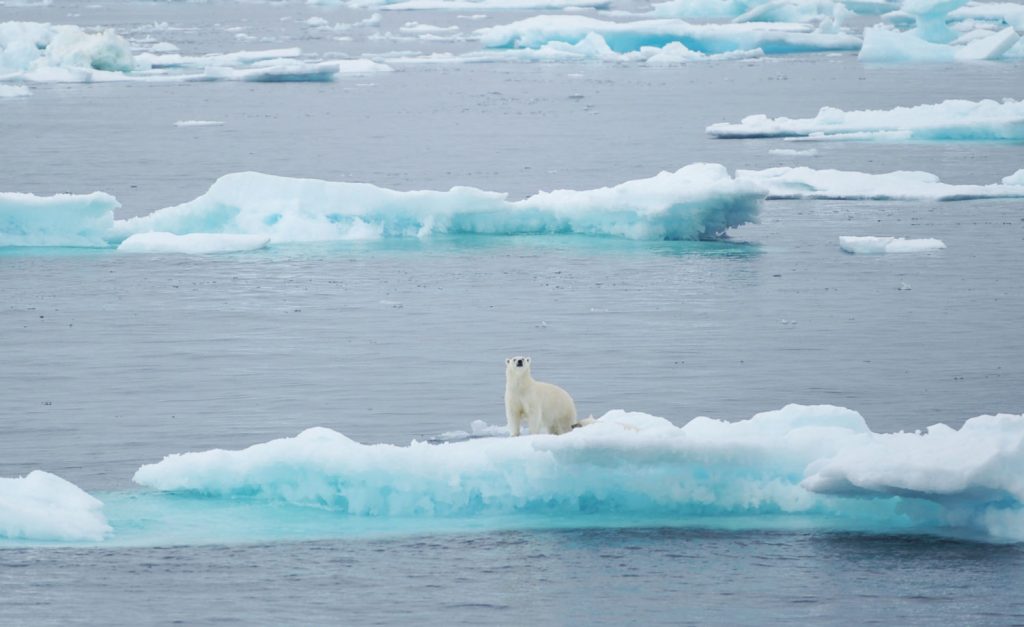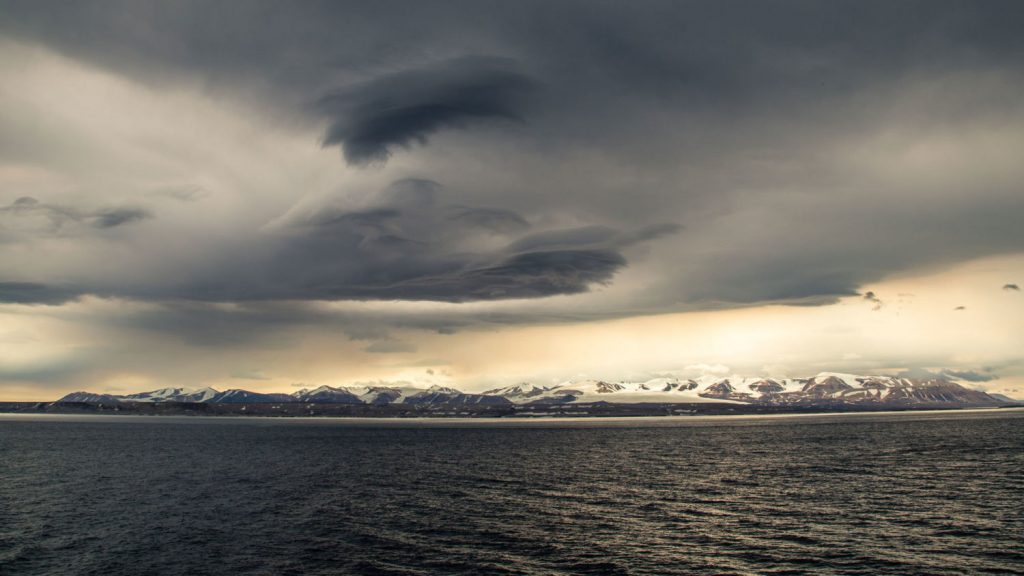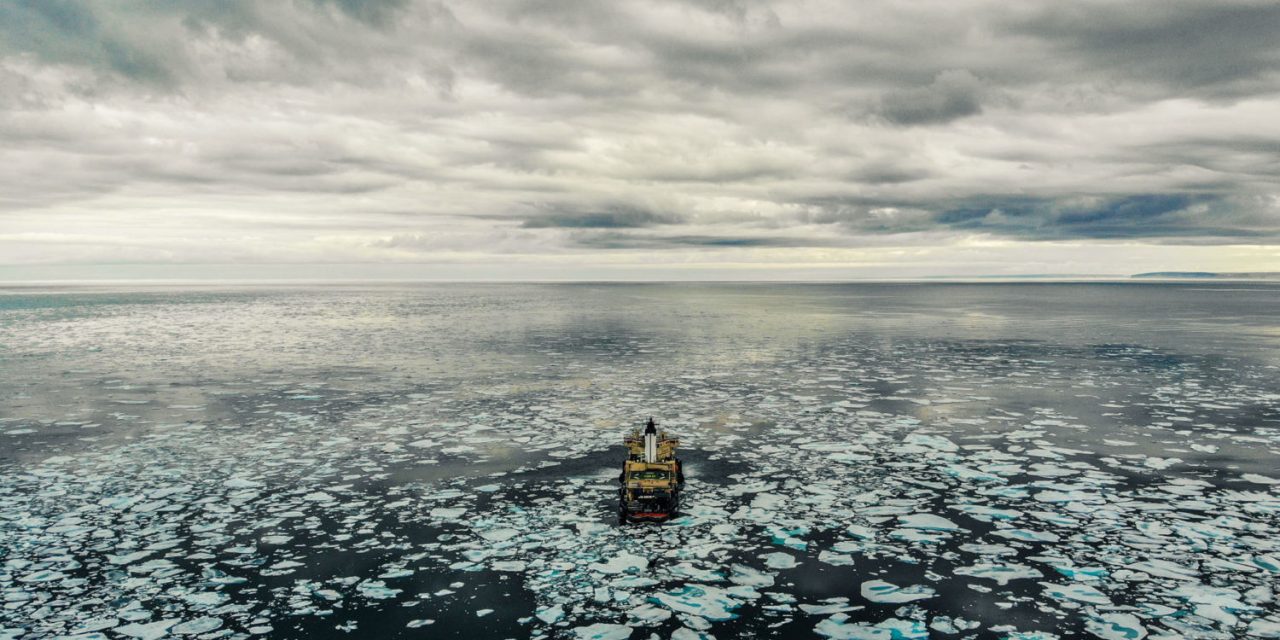Written by Ed Struzik / Yale Environment 360
After decades of travel in the Far North, E360’s Arctic correspondent joins a voyage through the Northwest Passage and witnesses a world being transformed, with ice disappearing, balmy temperatures becoming common, and alien invaders – from plastic waste to new diseases – on the rise.
Elwin Bay is carved into a steep, flat-topped mountain range along the northeast coast of Somerset Island in Canada’s High Arctic. For as long as anyone can remember, hundreds of beluga whales show up every year on an annual migration from Greenland through Canada’s Northwest Passage. Their fidelity to this site is remarkable given that 19th-century whalers killed more than 10,000 of them there – 840 during one notably gruesome, 17-day stretch – between 1874 and 1898.
Helicoptering over the bay earlier this month with members of a U.S. National Science Foundation-sponsored research expedition, we saw too many belugas to count accurately in waters riddled with rapidly disintegrating sea ice. Five hundred? Eight hundred? None of us could estimate with certainty. All we knew was that there were likely equal numbers of whales congregating in similar bays and estuaries, such as Cunningham Inlet, which we sailed past a few days earlier.
Polar bears were there as well — a female and cub in this case, homing in on a dead beluga that had presumably swum too far up the shallow estuary before the tide turned and trapped it.
I had joined the Northwest Passage Project on its 18-day, 2,000-nautical-mile icebreaker journey from Greenland through the high Canadian Arctic. Scientists and students aboard the ship were conducting oceanographic experiments to better understand the profound changes occurring in the Arctic Ocean as summer sea ice disappears and as alien invaders — from microscopic plankton and exotic fish species to large quantities of marine plastic — pour into this once-frozen region.

A film crew from the Oden explores Cunningham Inlet, which historically would have been blocked by sea ice in July. COURTESY OF TOMER KETTER
For me, having spent 40 years traveling extensively in the Arctic, the voyage was another unsettling reminder that the region has gone well beyond a climate change tipping point and is now “transforming into a new state,” as a Queen’s University geographer put it. This upheaval was evident from the record warmth and melting we saw in Greenland, to the widespread lack of sea ice along much of our route, to the stories of ecological disruption recounted by the Inuit who joined us aboard the Swedish icebreaker, Oden. I repeatedly found myself thinking about numerous prior explorations of the Northwest Passage in which expedition after expedition was blocked by sea ice — an obstacle that is fast disappearing.
As the hundreds of beluga in Elwin Bay showed, the Arctic is still a region teeming with marine mammals and abundant birdlife. It was thrilling to see other whale species such as tusked narwhal diving and giant bowheads blowing water 20 feet into the air. Watching long-tailed jaegers ceaselessly bullying kittiwakes to force them to disgorge a meal of fish was spellbinding.
That I didn’t see nearly as many polar bears as I had observed on similar expeditions in the past was not surprising given the paucity of ice. It may be only a matter of time before the fat, healthy bears we saw on this trip suffer the same fate as those in the southern Beaufort Sea, where numbers declined as much as 40 percent from 2001 to 2010. In a recent study, scientists at the U.S. Geological Survey (USGS) found that as sea ice declines, the bears are traveling farther and finding it harder to find seals.
The influx of contaminants such as mercury and plastics, which this expedition found in multi-year sea ice, is further testing the resilience of these and other animals at a time when unprecedented warming is not only melting sea ice but also thawing permafrost and providing southern animals — even grizzly bears — with opportunities to expand their range northward. Scientists are concerned that the arrival of new species may usher in alien diseases such as marine phocine distemper, which many Arctic marine mammals have no immunity to.

The route traveled by the Northwest Passage Project in July and August, from Greenland through the Canadian Arctic. YALE ENVIRONMENT 360
“Surveys such as this one are few and far between in the Arctic,” said Donglai Gong, an oceanographer from the Virginia Institute of Marine Science. “The Arctic is currently experiencing the fastest warming on Earth and dramatic changes in water chemistry. Ocean acidification puts the entire Arctic food web at risk. The rate of change challenges even the most adaptable of organisms.”
That climate upheaval was evident when we arrived at Thule Air Base. July temperatures in Greenland soared up to 18 degrees Fahrenheit above normal. (As it turned out, this July proved to be the hottest month ever recorded on the planet.) Nearly 200 billion tons of ice on the Greenland icecap melted that month. A record 55 billion tons disappeared from July 30 to August 3 — two days before the expedition ended. Wildfires, which until just a few years ago were virtually unheard of in Greenland, were burning the tundra both there and across the Arctic at a record rate. Just before the Oden departed for Canada, hikers on Greenland’s Arctic Circle Trail were being told to avoid a portion of the 100-mile route linking Sisimiut and Kangerlussuaq after two Americans had to be evacuated when they become disoriented in thick smoke.
By the time the Oden set sail, more than 100 “intense and long-lived wildfires” had already burned above the Arctic Circle this summer, according to the European-based Copernicus Atmosphere Monitoring Service. In June alone, these fires emitted as much as 50 megatons of carbon dioxide, equal to what all of Sweden emits in a year. Soot from these fires was falling on and darkening the icecaps and glaciers we steamed past, absorbing more heat from the sun.
As the Oden sailed from the Thule base, located at 76 degrees north, into the Canadian Arctic Archipelago, the fact that sea ice loss was on track to break the record set in 2012 became increasingly obvious. There was no ice for the Oden to break through as it crossed Baffin Bay, nor was there any appreciable ice in Lancaster Sound, north of Baffin Island — all of which meant that polar bears and walruses in the area were being deprived of a crucial platform on which to hunt and rest.

A polar bear in the Barrow Strait. As summer sea ice disappears in the High Arctic, polar bears are losing crucial platforms on which to hunt and rest. ED STRUZIK/YALE E360
On this oceanographic expedition, the scientists and students on the Oden weren’t as focused on seeing wildlife or seabirds, as they were in tracking the changes in sea ice, ocean temperature, and seawater chemistry that are driving ecosystem shifts in the region. Significant changes in one or more of these areas, said Gong, could trigger major transformations in the ecosystem. Scientists are already seeing this in Hudson Bay, where capelin have overtaken Arctic cod as the chief source of prey for seabirds such as thick-billed murres. In the central and eastern Arctic, where we were sailing, Inuit fishermen have even caught Pacific salmon, far from their home range.
Gibson Porter, a young Inuit man from Gjoa Haven, shared similar observations one morning when we were on the bridge of the Oden. Porter’s village was named in honor of the ship, the Gjoa, which was commanded by polar explorer Roald Amundsen, whose 1903-1906 expedition was the first to traverse the Northwest Passage. On that voyage, Amundsen spent nearly two years trapped in ice in a harbor near Gjoa Haven.
As Porter flipped through a book on birds, he began telling me about the changes he and other Inuit were witnessing in his village and on surrounding King William Island. At least four grizzly bears have taken up residence on the island, an unprecedented event in Inuit memory. Indeed, grizzly bears are extending their reach hundreds of miles from the mainland of the western Arctic, sometimes even mating with polar bears.
“We’re seeing all kinds of birds and animals that we have never seen before — gray jays, mallards, and Bank’s swallow, which is almost never found north of the Hudson Bay lowlands,” said Porter.

An abandoned Hudson’s Bay trading post on Somerset Island that was shut down in 1948 because supply ships could not get through the thick sea ice. COURTESY OF TOMER KETTER
Not long after our conversation, the Oden anchored at the southern end of Prince Regent Sound near Bellot Strait so that a few of us could be helicoptered to Fort Ross, site of an abandoned Hudson’s Bay Company trading post on the southern end of Somerset Island. The post was shut down in 1948 because supply ships could not find a way through thick ice. Standing on a rock-strewn rise, we could see two polar bears on a platform of sea ice searching for seals. The quintessential Arctic scene stood in sharp contrast to a new one that presents itself here each summer. Now, as many as eleven cruise ships sail through Bellot Strait so that tourists from around the world can disembark.
Another Inuit member of our expedition, educator Mia Otokiak, said that on her native Cambridge Island, thawing permafrost is creating giant sinkholes that have swallowed up snowmobiles and all-terrain vehicles. Thousands of muskox on Victoria Island, where she lives, have fallen ill, some fatally, as a result a novel form of lungworm; researchers believe that warmer Arctic temperatures are enabling the worm’s larvae to flourish. The Dolphin and Union caribou herd, which spends the summer on Victoria Island and the winter on the mainland, has been reduced to 15,000, half of their number in the 1990s. Warming temperatures have resulted in animals breaking through melting sea ice as they move to and from the mainland.
“It used to be that we didn’t have to go far to hunt caribou and muskox,” she added. “But that’s not the case anymore. There are some people who still deny that is because of climate change, but that is getting harder to do.”
During our voyage through Barrow Strait, scientists drilled cores into the melting sea ice. Initially, scientist Alessandra D’Angelo, a post-doctoral student at the University of Rhode Island’s School of Oceanography, wasn’t sure what to make of the red beads and colored threads that dominated the ice core samples she saw under the microscope. But a second look by colleague Jacob Strock confirmed what they both suspected: The rainbow of colors represented microscopic plastic particles.


Project scientist Jacob Strock examines microscopic particles of plastic trapped in sea ice [right]. ED STRUZIK/YALE E360
Given the difficulty and expense of conducting research in the Arctic, scientists say they are struggling to monitor the region’s transformation. The need for more research was driven home when we reached Prince Leopold Island, the second-to-last last stop on our journey back to Greenland. Rising to a height of 870 feet in the middle of Barrow Strait, this barren island is dominated by a flat-topped mountain bluntly cropped on all sides by scree slopes that descend at angles of nearly 90 degrees. As lifeless and uninviting as it looks from a distance, Prince Leopold is the most important bird sanctuary in the Canadian Arctic. Hundreds of thousands of birds, representing 47 species, breed on the island.
Unfortunately, bird research on Prince Leopold Island largely ended in 2012 due to a lack of funding. After the research was shut down, Canadian Wildlife Service seabird expert Tony Gaston wrote a paper outlining the dramatic changes he and others had documented on Prince Leopold over a 37-year period. Rain, Gaston pointed out, never fell heavily on the island until the turn of this century, when it occurred 13 times in 12 years. Ivory gulls, once a common visitor, have not been seen since 2003. Peregrine falcons, which were never seen in the 1970s, have been observed frequently since 2000. Gaston’s list of changes is long, and he and others say ongoing monitoring is needed to keep track of these shifts. One result of the paucity of research and planning is that only 5 to 7 percent of the biological hotspots in the Canadian Arctic — places like Prince Leopold Island — are protected in some way, according to a recent paper.

Lancaster Sound, south of Devon Island, was largely ice-free during the voyage, unusual for this time of year. COURTESY OF TOMER KETTER
By the time our 18-day expedition ended, researchers had collected more than 1,500 chlorophyll samples, which identify what kind of phytoplankton and bacteria are present at various depths in the open ocean and beneath the ice. The nature of these species tends to differ with temperature, water pressure, and chemistry. It will be some time before this and other oceanographic data are fully analyzed. But no one doubts that these snapshots of what is happening in the Arctic Ocean will reaffirm that a new Arctic is unfolding. “The question that remains to be answered,” said Gong, “is how and in what ways.”
When we returned to Thule, we were again greeted by exceptionally balmy weather, with temperatures nearing 70 degrees F. As we waited for a C-17 to fly us back to New York, many of us sunned ourselves in shirtsleeves on the outdoor patio of the community center. There was not cloud in the sky, nor any sea ice in the ocean. The only reminder that we were in northern Greenland were the icebergs drifting by that had calved off the island’s rapidly melting glaciers.
Canadian author and photographer Ed Struzik has been writing on environmental issues for three decades. He is the author of Firestorm: How Wildfire Will Shape Our Future and a fellow at the Institute for Energy and Environmental Policy at Queens University. MORE →

